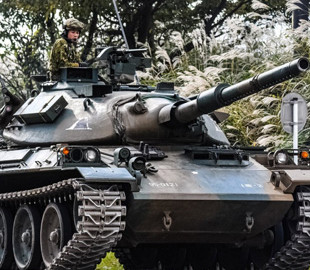
The Ground Forces of the Japanese Self-Defense Forces have completed the decommissioning of the Type 74 tank, which served for almost 50 years years and, despite its moral obsolescence, remained in service as the third type of tank in the country along with the Type 90 and the newest Type 10.
The very process of decommissioning the machine has been going on for a long time, since 2018, even before the Japanese Ministry of Defense approved the medium-term development plan until 2031, which provided for the replacement of the Type 74 tank with the Type 16 wheeled tank, which has a narrow anti-tank specialization.< /p>
But now it is completely completed and the last units, which, as Janes writes based on his own sources, are the 9th and 10th tank battalions, have already handed over the equipment. In general, we are talking about the last 90 tanks that should be scrapped.
And it is worth noting right away that Japan's export self-restrictions do not allow it to sell weapons to countries at war. Only after recent changes in export regulations has it become possible to sell individual components and equipment that are not lethal in themselves (for example – an engine for a tank, but not the tank itself). Moreover, in general, the export of Japanese weapons in modern history began only in 2020, and before that it was prohibited at all.
And also the fact that the Type 74 itself is, of course, a morally outdated machine, the history of which begins in the 60s, when it turned out that the then Type 61 with a 90 mm gun was inferior to the Soviet T-62, both in terms of protection and and penetration compared to its 115-mm gun. And due to the fact that the small width of the Type 61 did not allow installing a 105-mm Royal Ordnance L7 turret on it, a new machine had to be developed.
The T-62 itself, as the enemy, and European tanks, the German Leopard 1 and the French AMX-30, became benchmarks for the development carried out by Mitsubishi Heavy Industries. This was due to the requirements for car mobility and weight reduction at the price of booking. Although the Japanese managed to weigh 38 tons, which is 2-4 tons less (depending on the modernization) than the Leopard 1, to surpass the German tank in terms of armor.
When using similar steel armor, the Japanese machine received approximately 40% more powerful protection in the frontal projection, and weight savings were achieved due to the smaller dimensions of the machine.
As part of the fight against weight and dimensions, they even wanted to install an automatic loader in the Type 74, but the design turned out to be complicated, expensive and slow. Therefore, the car received a classic composition of four crew members. The car's mobility was provided by a 750-horsepower 10ZF Model 21 air-cooled diesel engine, which was paired with a MT75A manual gearbox (five gears forward, one reverse). This provided a specific power at the level of 19 hp/t and a maximum speed of up to 60 km/h (with a claimed 53 km/h).
And due to the peculiarities of the mountainous landscape of Japan, the Type 74 received an innovative at that time hydraulic suspension on five support rollers with adjustment not only of clearance, but also of inclination: up to 6 degrees on the nose-stern axis and up to 9 degrees between the sides.
A licensed copy of the Royal Ordnance L7 rifled 105-mm gun, for the installation of which the tank was created, was supplemented with a two-axis stabilizer with an electromechanical guidance drive, a laser rangefinder and a ballistic calculator. Tanks immediately gained the ability to fight at night due to passive night vision devices with the possibility of additional illumination by an IR searchlight.
The tank was adopted in 1974 and unexpectedly became obsolete with the appearance of the Leopard 2, which began to be supplied in 1979. year to the Bundeswehr. This prompted Tokyo to begin work on the Type 90 and upgrade the Type 74, of which a total of 893 were produced. But the machine did not receive significant upgrades, only the fire control system was updated. And despite the plans, due to weight restrictions, the installation of dynamic protection was not implemented.

